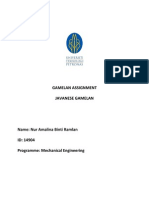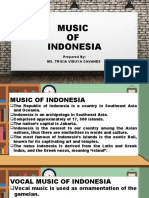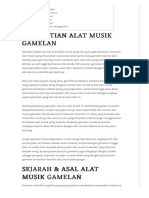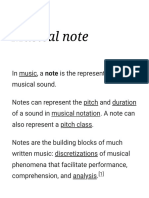0 ratings0% found this document useful (0 votes)
122 viewsMudavose Gamelan Music Presentation
Mudavose Gamelan Music Presentation
Uploaded by
TAPIWA CHENJERAIGamelan is a traditional Indonesian orchestra that originated in Java and Bali. It uses various percussion instruments such as metallophones, gongs, drums, and cymbals. The most common types of Gamelan ensembles are from Bali and Java. Gamelan music is integral to rituals and ceremonies and accompanies dance. It features complex, interlocking rhythms and heterophonic textures. Well-known instruments include the bonang, gender, sarong, kenong, and kendhang drums.
Copyright:
© All Rights Reserved
Available Formats
Download as PPTX, PDF, TXT or read online from Scribd
Mudavose Gamelan Music Presentation
Mudavose Gamelan Music Presentation
Uploaded by
TAPIWA CHENJERAI0 ratings0% found this document useful (0 votes)
122 views28 pagesGamelan is a traditional Indonesian orchestra that originated in Java and Bali. It uses various percussion instruments such as metallophones, gongs, drums, and cymbals. The most common types of Gamelan ensembles are from Bali and Java. Gamelan music is integral to rituals and ceremonies and accompanies dance. It features complex, interlocking rhythms and heterophonic textures. Well-known instruments include the bonang, gender, sarong, kenong, and kendhang drums.
Copyright
© © All Rights Reserved
Available Formats
PPTX, PDF, TXT or read online from Scribd
Share this document
Did you find this document useful?
Is this content inappropriate?
Gamelan is a traditional Indonesian orchestra that originated in Java and Bali. It uses various percussion instruments such as metallophones, gongs, drums, and cymbals. The most common types of Gamelan ensembles are from Bali and Java. Gamelan music is integral to rituals and ceremonies and accompanies dance. It features complex, interlocking rhythms and heterophonic textures. Well-known instruments include the bonang, gender, sarong, kenong, and kendhang drums.
Copyright:
© All Rights Reserved
Available Formats
Download as PPTX, PDF, TXT or read online from Scribd
Download as pptx, pdf, or txt
0 ratings0% found this document useful (0 votes)
122 views28 pagesMudavose Gamelan Music Presentation
Mudavose Gamelan Music Presentation
Uploaded by
TAPIWA CHENJERAIGamelan is a traditional Indonesian orchestra that originated in Java and Bali. It uses various percussion instruments such as metallophones, gongs, drums, and cymbals. The most common types of Gamelan ensembles are from Bali and Java. Gamelan music is integral to rituals and ceremonies and accompanies dance. It features complex, interlocking rhythms and heterophonic textures. Well-known instruments include the bonang, gender, sarong, kenong, and kendhang drums.
Copyright:
© All Rights Reserved
Available Formats
Download as PPTX, PDF, TXT or read online from Scribd
Download as pptx, pdf, or txt
You are on page 1of 28
Presenter
R1814861T Mudavose Rovias
HISTORY OF THE GAMELAN
Gamelan dates back to before Hindu-Buddhist culture in
Indonesia and is a native art form.
In Javanese Mythology, it is believed that the Gamelan
was created by Sang Hyang Guru. He ruled from his
palace on the Maendra mountains.
He needed a way to summon the Gods, and so invented
the gong. For more complex messages, he invented two
more gongs and this formed the original gamelan set.
Gamelan is now played all over Indonesia but the most
popular types are Balinese and Javanese.
THE GAMELAN MUSIC OF INDONESIA
Bali is a small island in the Indonesia ocean. Part of
the huge nation of Indonesia made up of over 17000
islands from singapore in the west and australia in the
east.
Bali lies just east of java, indonesia’s most populated
island with the capital city of Dakata.
Indonesia is the world’s forth populated countries
(around 260 miliion).
They gained independence from the Dutch in 1945.
bali’s population is about 4.2 million.
Gamelan music
The word Gamelan is a generic term for various orchestras of tuned
percussion. There are more than 25 different kinds of Gamelan
differentiated by their size, number of instruments, tuning, repertoire
of pieces and function.
In Bali ensembles ranging in size from 4to 40 instrument.
The instruments may be made of bronze, which is most common or
bamboo or wood.
Some ensembles are very portable and small, while others are
extremely large and heavy so rarely moved.
Each gamelan has a unique tuning so there is no standard such as in
the Western music. Music compositions range from the so called
traditional and ageless to contemporary with known and much
respected composers.
Gamelan Music
Gamelan music is rarely played purely as concert music, more often
it accompanies dance and drama.
Gamelan music is also functional and is usually performed during
ritual ceremonies to please the Gods who are believed to also enjoy
music as much as humans do.
Although the ensembles are often large, and performs extremely
complex music, there is never a conductor. Instead signals are found
in the music or in the form of gestures from on or two of the leading
musicians. Gamelan music is performed with the musicians sited on
the ground.
Traditionally, and still most commonly gamelan musicians are all
male. However, for the last 25 years or more many female musicians
had appeared though mixed gender groups are quite rare.
Techniques of playing the instruments
Most of the instruments are made of bronze so there is
need for dampening the notes after playing to avoid the
sound mixing together. What the players do is when …
The instruments are built in pairs but tuned deliberately
very slightly differently so as to create some kind of a very
brilliant and shimmering effect (waves) between the notes.
The compositions are built on melodies that are 4, 8, 16
(multiples of 4 ) beats in length. The cycle of these
melodies are articulated by the gong. The melodies are
elaborated with parts that interlock and fit together. One
melody will be on beat and the other off beat.
Facts about Gamelan
Before entering the area of the orchestra, shoes must
be removed.
Stepping over the instruments is forbidden
The instruments are said to have a connection with
the Gods therefore stepping over them breaks that
connection.
The instruments of the Gamelan orchestra
All instruments of the gamelan orchestra are all made
by highly-skilled craftsmen in village workshops, and are
sacred to the Balinese villages.
The instrument subgroups are idiophones which
include metallophones, gongs, and cymbals;
membranophones including wooden drums with heads
made from animal skin; aerophones which are
instruments made from a bamboo tube (blown similar
to Western woodwind instruments); and chordophones
which are types of string instruments (Bali Beyond,
2014)
The Bonang
The Bonang is very important for the melody in many
pieces of Gamelan music.
In lots of loud pieces, the Bonang plays a more
elaborate version of the basic melody.
The Bonang
Gender
Gender are played with two hands, each holding a
mallet with a padded disk-shaped head.
Because the instrument has a strong sustain, the
sound must be dampened with the wrists after striking
the next note.
Gender
The Saron Family
There are three instruments in the Saron family.
The demung is the largest and lowest of the family.
It is played with a hammer with a wooden head.
Saron barung is somewhat smaller than the demung.
Its bars sound an octave higher.
The peking is small and plays an octave higher than
the Saron Berung.
The musician uses a hammer made from an animal
horn.
The Saron
The Kenong
The musician sits in the middle of the kenong.
Kenong beaters are large sticks with a padded end.
Normally, the musician will play a kenong and let it
ring.
The Kenong
The Gong Suwuk
The gong suwuk are large gongs of definite pitch. The
gong ageng are very important to the Gamelan.
They mark the end of major divisions called gongan.
The big gong is also used when ending most pieces.
The Gong Suwuk
The Kempul
The Kempul are a set of pitched gongs.
These instruments often subdivide a line of Gamelan
music.
There are two racks of gongs because of the two
Gamelan scales called laras.
The Kempul
The ceng-ceng
Theceng-ceng consists of a set of four small cymbals
mounted inverted on a wooden frame, which are
struck with a pair of small cymbals held by the
musician to create crashing and shimmering effects.
Drums/Kendhang
There are several drums or kendhang of different sizes
in a Gamelan ensemble but not all of the drums are
necessarily played in one piece.
The laced drums have skin heads on both sides and
are played with the hand.
Drums/Kendhang
Gamelan Rhythm
Gamelan music interprets complex polyrhythms and
complex rhythmic patterns.
Although each separate rhythmic part itself is simple, the
interlocking rhythmic patterns create an excessive and
lively effect, making these combinations sound complex.
In saying this, all rhythms created compliment each other
very well.
The rhythmic characteristic of ostinatos are used
frequently in gamelan, and is usually played by the
Kempli or the Kajar.
Gamelan rhythm
Generally, most Balinese compositions are written in
simple meter where the strong beats fall on the second
and fourth beats of each bar, rather than on the first
and third beats of each bar like in most Western
music.
The gongs hold the role of marking structural points
within music, and therefore only play notes with
longer values such as minims or semibreves.
Gamelan rhythm
Traditionally, in a sixteen measured cycle; the small gong will
strike once every odd-numbered measure, the middle gong will
strike every fourth, eighth, twelfth, and sixteenth measure, and
the large gongs; Gong Wadon and Gong Lanang, will strike only
on the sixteenth measure to symbolise the end of the cycle (Bali
Beyond, 2014).
Gamelan music interprets complex polyrhythms and complex
rhythmic patterns.
Although each separate rhythmic part itself is simple, the
interlocking rhythmic patterns create an excessive and lively
effect, making these combinations sound complex. In saying
this, all rhythms created compliment each other very well
Gamelan melody
Kotekan is the unique sound of the Balinese gamelan
meaning ‘flowers’ and referring to the interlocking parts
played by two paired instruments such as the Gangsa,
Kantilan, or Reong.
The two parts; named polos and sangsih are highly
syncopated and interlock tightly.
This produces the effect of one seamless stream of melody.
Melodies are scalar and only sometimes jump by leaps.
The overall direction of melody is ascending and a
recognisable melodic structure is created through the use
of phrases mentioned earlier.
Gamelan texture
The texture of Balinese gamelan music is highly layered, and a
complex polyphonic texture is created.
The large usage of doubled instruments creates ombak (acoustic
beating), and resulting in thick textures is also developed.
A heterophonic texture, with different types of variation assigned
to different instruments, characterises the gamelan music of
Indonesia.
This complex heterophonic texture results from simultaneous
performances of melodic variants of the same tune.
Overall, the texture of Balinese gamelan music is very thick
however changes in this texture can change throughout solo
sections, as well as through slower variations within a piece.
You might also like
- Bat Boy Script - CompleteDocument93 pagesBat Boy Script - CompleteBelén Astor Martín Rapónchigo100% (10)
- Tints TabDocument3 pagesTints Tababca61251No ratings yet
- Merry Go Round of Life For Clarinet and PianoDocument7 pagesMerry Go Round of Life For Clarinet and PianoDamián Azael Guzmán Báez33% (3)
- Southeast Asian MusicDocument5 pagesSoutheast Asian MusicPRINTDESK by Dan86% (22)
- Gamelan AssignmentDocument7 pagesGamelan AssignmentNur Amalina RamlanNo ratings yet
- The Blues by David Bakerpdf PDF FreeDocument109 pagesThe Blues by David Bakerpdf PDF FreeRafael Toledo Sarmento Ribeiro100% (5)
- Music 8 LP Ist QDocument4 pagesMusic 8 LP Ist Qrommel mukayNo ratings yet
- Indonesian Gamelan MusicDocument9 pagesIndonesian Gamelan MusicEsther ChuaNo ratings yet
- Instrumental Music of IndonesiaDocument11 pagesInstrumental Music of IndonesiaBrianne PimentelNo ratings yet
- Reporting (Indonesia)Document76 pagesReporting (Indonesia)John PoeNo ratings yet
- Traditional Musical Instrument From Regions of IndonesiaDocument10 pagesTraditional Musical Instrument From Regions of IndonesiaSusan PascualNo ratings yet
- Music of IndonesiaDocument19 pagesMusic of IndonesiaTricia CavanesNo ratings yet
- Gamelan: Tuned PercussionDocument3 pagesGamelan: Tuned PercussionJjwNo ratings yet
- 1ST Quarter Lesson 1 in Music 8Document30 pages1ST Quarter Lesson 1 in Music 8chriskarguNo ratings yet
- Unit IDocument21 pagesUnit IMelbourne Therese AraniadorNo ratings yet
- The Music OF IndonesiaDocument82 pagesThe Music OF IndonesiaJohn PoeNo ratings yet
- MUSIC AND ARTS HandoutsDocument5 pagesMUSIC AND ARTS Handoutscyrine joy simbanaganNo ratings yet
- Gamelan HandoutDocument18 pagesGamelan HandoutttkmionNo ratings yet
- Write Up - GamelanDocument1 pageWrite Up - GamelanDhyana SrinivasanNo ratings yet
- Music of Indonesia: DCC Registered Qms-Dcc-Form16Document25 pagesMusic of Indonesia: DCC Registered Qms-Dcc-Form16Dominic CorreaNo ratings yet
- Music Lesson 1 - Grade 8Document4 pagesMusic Lesson 1 - Grade 8gotsome jams here u want?No ratings yet
- Gamelan IndonesiaDocument14 pagesGamelan IndonesiaJunior Celestinus100% (1)
- Kulintang and Bamboo EnsembleDocument8 pagesKulintang and Bamboo EnsembleBreanna Gael SaludesNo ratings yet
- 1ST Quarter Mapeh NotesDocument15 pages1ST Quarter Mapeh NotesZe-zeNo ratings yet
- The Gamelan Music of Indonesia SummaryDocument5 pagesThe Gamelan Music of Indonesia SummaryEdward O' GormanNo ratings yet
- Week 2 - Music and ArtsDocument19 pagesWeek 2 - Music and Artsabegail.faderogaoNo ratings yet
- Music of Indonesia. Location: Gamelan Is The Most Popular Form of Traditional MusicDocument3 pagesMusic of Indonesia. Location: Gamelan Is The Most Popular Form of Traditional MusicNatalya SongcalNo ratings yet
- Music of IndonesiaDocument81 pagesMusic of Indonesiagonzalesjohnlloyd12No ratings yet
- Materi GamelanDocument14 pagesMateri Gamelanjacksragen2No ratings yet
- Music 8, 1st QuarterDocument23 pagesMusic 8, 1st QuarterRonith Nikki PacisNo ratings yet
- Music of Southeast AsiaDocument25 pagesMusic of Southeast AsiaJohn PlayzNo ratings yet
- Music of IndonesiaDocument23 pagesMusic of IndonesiaSepida MolzNo ratings yet
- Indonesianmusic 140623074828 Phpapp01Document23 pagesIndonesianmusic 140623074828 Phpapp01Nathaniel Ebreo CatbaganNo ratings yet
- Indonesian InstrumentDocument8 pagesIndonesian InstrumentTinay KatigbakNo ratings yet
- GamelanDocument2 pagesGamelanMatthew Russell100% (1)
- Musical Instruments of Peninsular MalaysiaDocument24 pagesMusical Instruments of Peninsular MalaysiaAudrena Sany AlbertNo ratings yet
- Indonesian MusicDocument25 pagesIndonesian MusicJayson Peralta ValdezNo ratings yet
- Indonesian Musical InstrumentsDocument5 pagesIndonesian Musical Instrumentspcjohn computershopNo ratings yet
- Indonesian Music PowerPoint Wb86dlDocument10 pagesIndonesian Music PowerPoint Wb86dlJohn PoeNo ratings yet
- Music Lecture GAMELANDocument10 pagesMusic Lecture GAMELANStanley T. VelascoNo ratings yet
- Music-8Document9 pagesMusic-8mitchikatsxNo ratings yet
- Indonesia: Gamelan EnsembleDocument20 pagesIndonesia: Gamelan EnsembleIan AtienzaNo ratings yet
- Musical Features: Indonesia: GamelanDocument2 pagesMusical Features: Indonesia: GamelancarolyaoNo ratings yet
- Music of IndonesiaDocument33 pagesMusic of IndonesiaDann PagaduanNo ratings yet
- CambodiaDocument5 pagesCambodiaNiel S. DefensorNo ratings yet
- AOS2 ChecklistDocument8 pagesAOS2 ChecklistticklyearsNo ratings yet
- Music and Arts 2gDocument17 pagesMusic and Arts 2gKim NicolasNo ratings yet
- Music of Cambodia and IndonesiaDocument15 pagesMusic of Cambodia and IndonesiaSai Cabarles BermasNo ratings yet
- G8 MUSIC PpresentationDocument147 pagesG8 MUSIC PpresentationSam david H UrsuaNo ratings yet
- Indonesia ReportDocument28 pagesIndonesia ReportNatalya SongcalNo ratings yet
- Musical Instrument of IndonesiaDocument10 pagesMusical Instrument of Indonesiagabrielluis08100% (4)
- Week 5 Modules in Music 8Document8 pagesWeek 5 Modules in Music 8Israel Marquez100% (2)
- Music-of-Indonesia-Myanmar-1st-QuarterDocument4 pagesMusic-of-Indonesia-Myanmar-1st-Quarteradjhapannogan96No ratings yet
- Elective 1 ReviewerDocument11 pagesElective 1 ReviewerdiarydenieNo ratings yet
- Mic Essay 3bDocument5 pagesMic Essay 3bSheng Jun NgNo ratings yet
- IndonesiaDocument16 pagesIndonesiaAerol QuizonNo ratings yet
- Grade 10-African InstrumentsDocument23 pagesGrade 10-African InstrumentsAtriu FortezaNo ratings yet
- Group 3 - Indonesian Playlist & Javanese and Balinese InstrumentDocument22 pagesGroup 3 - Indonesian Playlist & Javanese and Balinese Instrument[AP-Student] Veronica San JuanNo ratings yet
- MusicDocument17 pagesMusicGrace ArmenioNo ratings yet
- Music in Indonesia: Philippine and Asian Music 1Document41 pagesMusic in Indonesia: Philippine and Asian Music 1Israel MarquezNo ratings yet
- Gamelan Presentation - First HalfDocument7 pagesGamelan Presentation - First HalfalicejoyhansenNo ratings yet
- Instrumental Music of Southeast AsiaDocument14 pagesInstrumental Music of Southeast AsiaMARK FABIAN VENTONo ratings yet
- The Hero Is Overpowered But Overly CautiousDocument101 pagesThe Hero Is Overpowered But Overly CautiousCarlord The CarGodNo ratings yet
- Musical Note - WikipediaDocument38 pagesMusical Note - WikipediaSamson OsintonaNo ratings yet
- Ángel Gregorio Villoldo: El Más Pesao Milonga CriollaDocument4 pagesÁngel Gregorio Villoldo: El Más Pesao Milonga CriollaOctávio MachadoNo ratings yet
- Cryof My HeartDocument5 pagesCryof My HeartDavidNo ratings yet
- The Original Broadway Cast Recording of CompanyDocument10 pagesThe Original Broadway Cast Recording of CompanyJacob RomanNo ratings yet
- Katamari Damacy - OvertureDocument1 pageKatamari Damacy - OvertureEdward WellmanNo ratings yet
- Folk Music of Cordillera Mindoro PalawanDocument28 pagesFolk Music of Cordillera Mindoro PalawanshaleecaraanNo ratings yet
- Francis PlanteDocument20 pagesFrancis PlanteHambourg MarkNo ratings yet
- Copy of Theatre Arts 1 Final ExamDocument6 pagesCopy of Theatre Arts 1 Final ExamnailaabacaNo ratings yet
- Hit Song Chord Volume 1Document48 pagesHit Song Chord Volume 1MOHAMED QADRI BIN MOHAMED SAHAIMI MoeNo ratings yet
- Wooden Broomstick - BassonDocument2 pagesWooden Broomstick - BassonMathieu MoreaudNo ratings yet
- Alma Redemptoris Mater By: Giovanni Pierluigi Da PalestrinaDocument3 pagesAlma Redemptoris Mater By: Giovanni Pierluigi Da PalestrinaJuliana NascimentoNo ratings yet
- Carole King - You Make Me Feel Like A Natural WomanDocument3 pagesCarole King - You Make Me Feel Like A Natural WomanErika MennaNo ratings yet
- Shine Chords by Mr. BigDocument1 pageShine Chords by Mr. BigMoisés BonillaNo ratings yet
- Intro To Jazz - Jeremy Siskind - Tonebase WorkbookDocument44 pagesIntro To Jazz - Jeremy Siskind - Tonebase Workbookrifokok216No ratings yet
- The Journey WithinDocument2 pagesThe Journey WithinQuyênLêNo ratings yet
- Duvet by BoaDocument2 pagesDuvet by BoaRichmond ChanNo ratings yet
- Kill em AllDocument13 pagesKill em AllJohnGreenNo ratings yet
- The Wall Breaks Asunder W: SOLFEGEDocument10 pagesThe Wall Breaks Asunder W: SOLFEGEbridgetnperezNo ratings yet
- WP Contentuploads202202JAVS12 02 PDFDocument99 pagesWP Contentuploads202202JAVS12 02 PDFSárközi ÁronNo ratings yet
- Christgau's Record Guide: The '80s: Main Article: See Also: andDocument3 pagesChristgau's Record Guide: The '80s: Main Article: See Also: andMJ BotorNo ratings yet
- Chopin and His Ballade in A Flat MajorDocument3 pagesChopin and His Ballade in A Flat MajorSeunghyun RyuNo ratings yet
- From Treatise To Classroom Teaching Fifteenth-Century Improvised CounterpointDocument24 pagesFrom Treatise To Classroom Teaching Fifteenth-Century Improvised CounterpointJavier Vizcarra Pinto100% (1)
- Bei Mir Bist Du Schön 3Document2 pagesBei Mir Bist Du Schön 3Tobi RädleNo ratings yet
- What Is A Speech ChoirDocument33 pagesWhat Is A Speech ChoirJennifer JuatcoNo ratings yet
- The History of Jazz 2nd Edition Gioia All Chapters Instant DownloadDocument62 pagesThe History of Jazz 2nd Edition Gioia All Chapters Instant Downloadrapdenverrdi64100% (4)
- Choralnet Resources: Return To Resource ListDocument14 pagesChoralnet Resources: Return To Resource Listpire69No ratings yet

























































































